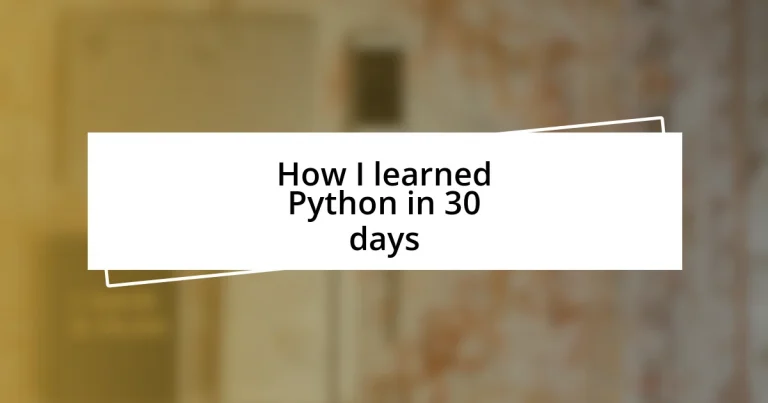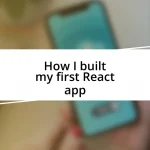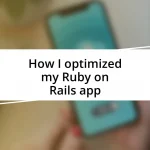Key takeaways:
- Setting clear learning goals and breaking down the process into manageable milestones helped maintain focus and motivation during the Python learning journey.
- Building practical projects provided hands-on experience, fostering a sense of achievement and creative exploration that reinforced coding skills.
- Joining online coding communities offered support, networking opportunities, and a platform for accountability, enhancing the overall learning experience.
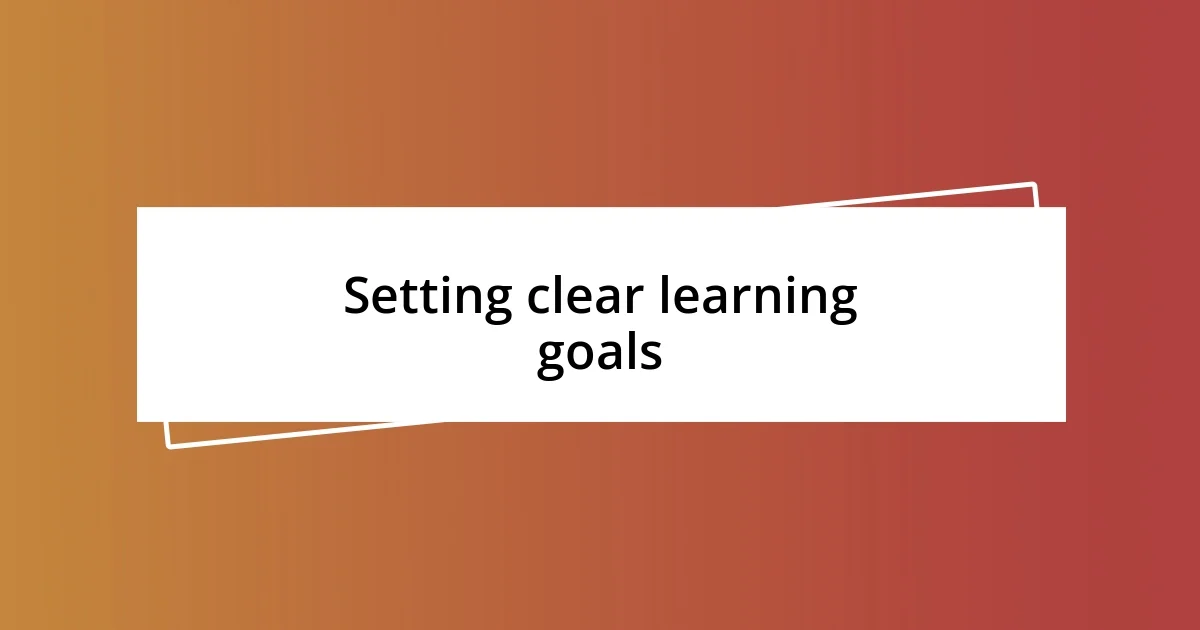
Setting clear learning goals
Setting clear learning goals is crucial in any endeavor, especially when diving into a language like Python. When I started my 30-day challenge, I created specific objectives, such as mastering basic syntax in the first week. This approach kept me focused and motivated, much like setting a destination for a road trip—it gives you a sense of direction and purpose.
I remember feeling overwhelmed during my first few days. And then it hit me: instead of vague aspirations, I needed detailed milestones. I broke down my learning into manageable chunks, like completing small projects or solving coding exercises. By celebrating these mini achievements, I found renewed energy and enthusiasm—a simple yet effective way to maintain momentum.
Have you ever found yourself drifting through a learning process without clear goals? I certainly have, and it often leads to frustration and stagnation. By committing to well-defined goals, I not only made my journey manageable but also more enjoyable. It turned an intimidating task into a series of small, conquerable steps that built my confidence along the way.
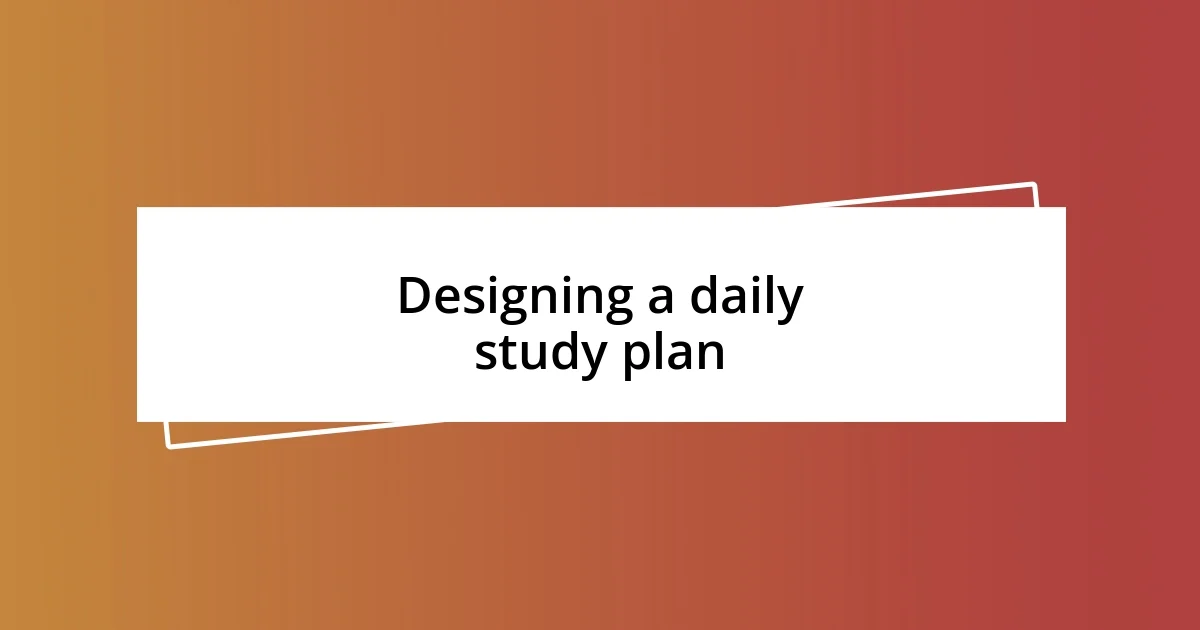
Designing a daily study plan
Designing a daily study plan is essential for effective learning. I found that structuring my time prevented me from feeling overwhelmed. I set aside specific hours each day dedicated to Python, turning study time into a non-negotiable part of my routine, much like my morning coffee ritual.
Here’s a sample daily study plan that worked wonders for me:
-
Weekdays:
- 9 AM – 10 AM: Review concepts from the previous day.
- 10 AM – 11 AM: Focus on coding exercises.
- 11 AM – 11:30 AM: Short break—grab a snack or go for a walk.
- 11:30 AM – 12:30 PM: Learn a new topic or chapter.
-
Weekends:
- 2 hours: Work on a mini-project incorporating this week’s lessons.
- 1 hour: Review and consolidate knowledge from the week, jotting down ideas or areas of confusion.
It’s funny how just establishing those dedicated hours transformed my perception of learning. Instead of slogging through a mountain of tutorials, I approached each session like a scheduled meeting with myself. And let me tell you, that slight shift made all the difference! I felt a sense of accomplishment at the end of each day, knowing that I was consistently progressing towards my goal.
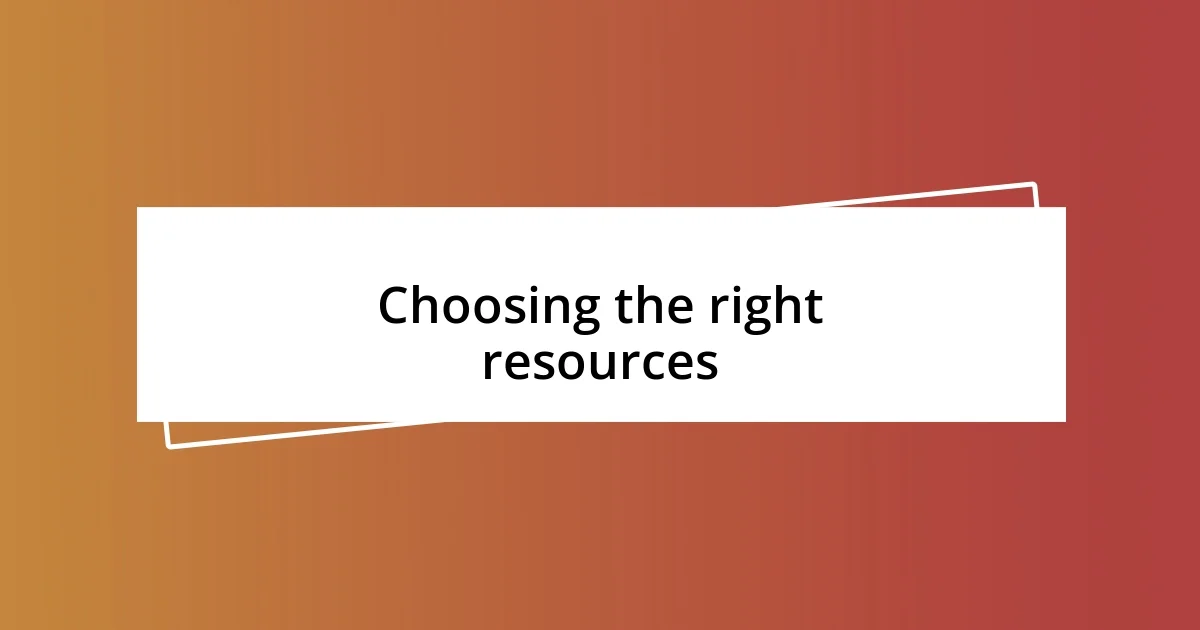
Choosing the right resources
Choosing the right resources is a game-changer in the learning process. When I embarked on my journey with Python, I quickly realized that not every tutorial or book fits everyone’s style. I explored online courses, video tutorials, and even community forums. The right resources for me were interactive platforms where I could practice coding right away. I vividly remember stumbling upon an engaging website where I could write code and receive immediate feedback. That instant gratification made my learning feel alive and effective.
As I sifted through various resources, I paid close attention to the teaching methods. Some platforms relied heavily on theory, while others emphasized practical, hands-on experience. For instance, I tried a few books that offered an exhaustive dive into Python, but soon discovered that I thrived on projects and coding challenges instead. It was like finding your favorite flavor of ice cream—once I hit the right one, my enthusiasm soared, and my progress accelerated.
Choosing the right resources also means considering your learning pace and style. Do you prefer visual aids or hands-on coding? Personally, I found video tutorials quite stimulating because I could see Python in action. But what about you? Think about what keeps you engaged and motivated. Remember, it’s not just about consuming knowledge; it’s about how you experience it.
| Resource Type | Pros |
|---|---|
| Online Courses | Structured learning with interactive elements. |
| Books | In-depth knowledge, great for reference. |
| Video Tutorials | Visual engagement, helpful for seeing coding in action. |
| Community Forums | Peer support, real-world problem-solving. |
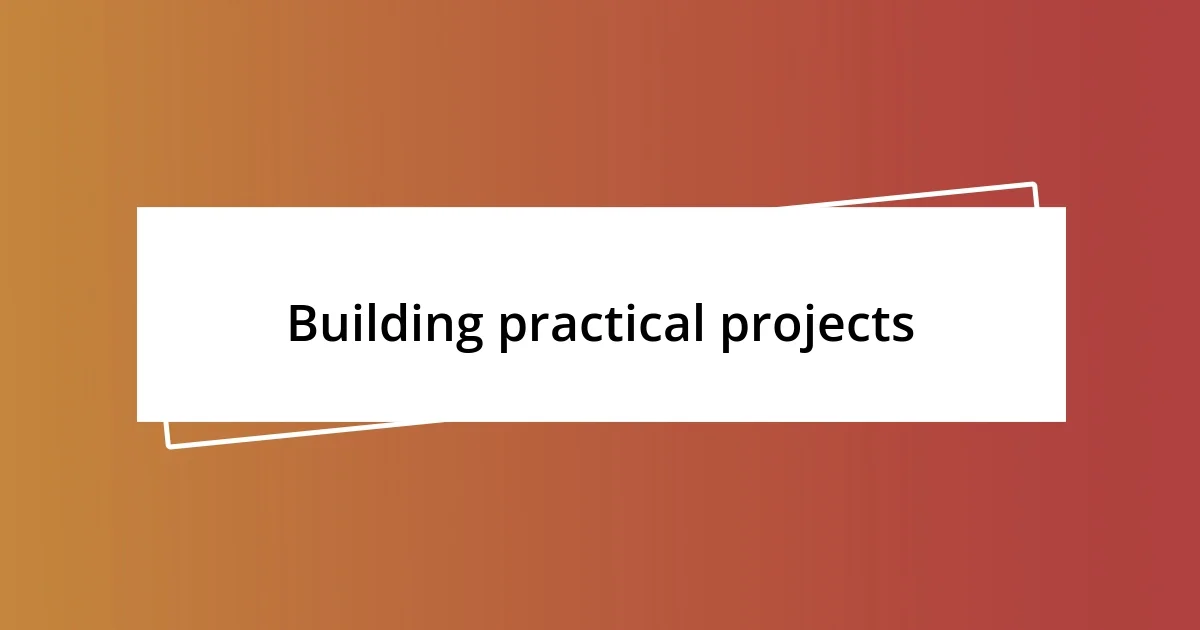
Building practical projects
Building practical projects was where the magic truly happened for me. I still recall the thrill of my first small project—a simple to-do list application. It started as a basic concept, but as I delved deeper into coding, it transformed into something I was proud of. Some nights, I’d sit at my desk, fueled by coffee, tweaking the design and functionalities. Every bug fixed felt like a mini-celebration! Have you ever experienced that rush when you finally make something work? It’s exhilarating.
As I continued to learn, I began challenging myself with more complex projects, like a weather app that pulled real-time data from APIs. Initially, the idea seemed daunting, but there’s a certain joy in piecing together the puzzle. When an app comes to life and serves its purpose, it feels like you’ve built a small piece of magic. I often found myself asking, “What can I create next?” This mindset led me to explore different programming concepts and stretch my creativity in ways I never thought possible.
I genuinely believe that the best way to internalize what you’ve learned is to build something meaningful to you. Whether it’s automating a mundane task or creating a game, practical projects allow you to see your knowledge in action. Reflecting on my experience, I realized that it wasn’t just about the code—it was about fostering a sense of achievement, staying motivated, and continuously pushing my limits. What projects are you itching to bring to life?
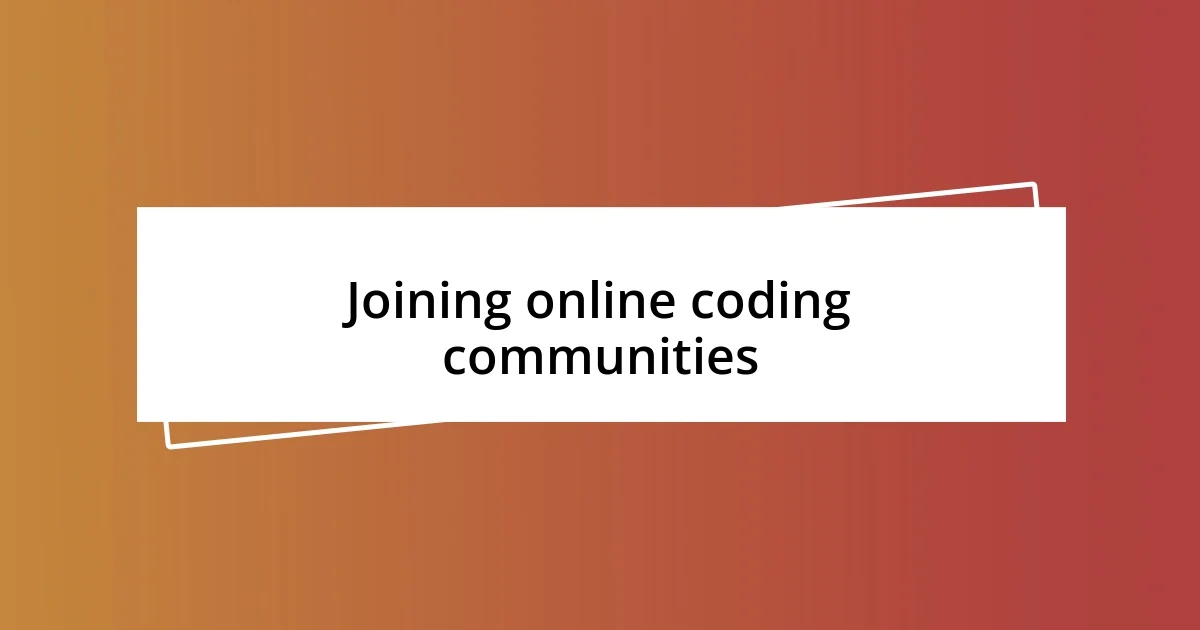
Joining online coding communities
Joining online coding communities was one of the best decisions I made on my Python journey. I remember my first foray into a coding forum; it felt like entering a bustling marketplace of ideas. Questions were flying, answers popping up, and I found it energizing to be surrounded by fellow learners and experienced coders alike. Have you ever walked into a room where everyone shares your passion? That sense of belonging is incredibly motivating.
As I engaged more with the community, I discovered something magical—it’s not just about asking questions; it’s also about giving back. Sharing my own insights after solving a tricky problem gave me a rush of confidence. It’s like a small circle of support where everyone lifts each other up. I often thought, “How can I contribute today?” This mindset shifted my focus from simply being a learner to becoming a part of something bigger, and it deepened my understanding of Python as I explained concepts to others.
Networking within these communities opened up real-world opportunities too. I recall connecting with a mentor who guided me through a challenging project. The experience not only boosted my skills but also showed me the power of collaboration. Have you considered how community support can elevate your learning experience? When we pool our knowledge and experiences, we create an invaluable resource that’s greater than any individual effort.
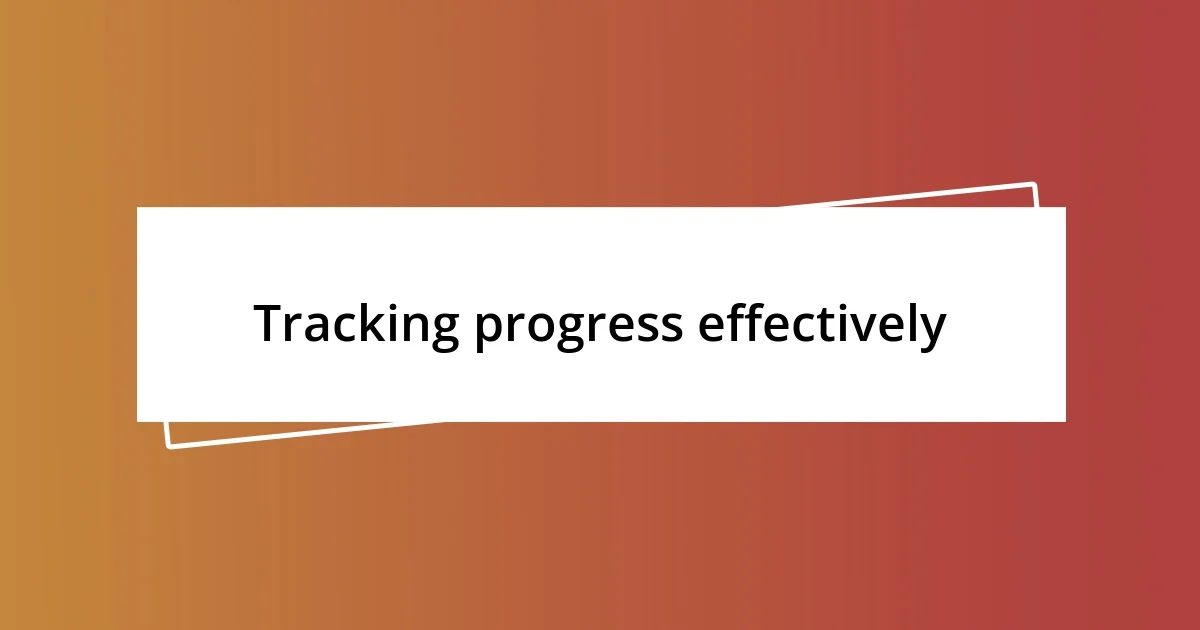
Tracking progress effectively
Tracking my progress effectively was a game changer in my Python journey. At the beginning, I set measurable goals, which transformed an overwhelming task into manageable milestones. For instance, I charted my learning path week by week, noting down what I’d learned and the projects I’d completed. There were days when I felt like I was stuck, but looking back at my progress made it clear how far I had come. Have you ever reflected on your growth? Those moments can reignite your motivation.
I also used a variety of tools to keep tabs on my progress. Simple spreadsheets tracked coding hours, while coding platforms like GitHub gave me a tangible portfolio of my work. There’s something rewarding about seeing your contributions accumulate over time. The first time I merged a pull request, I felt a surge of pride. It was proof that I wasn’t just learning—I was really becoming part of the coding community. How visible is your progress to you? Maybe it’s time to start documenting those achievements.
Additionally, I found that sharing my progress with others added another layer of accountability. I would post updates in the forums I was part of, and the encouragement from peers was incredibly uplifting. It felt like having a personal cheerleading squad. I remember one post where I shared a small win—a function I finally got right—and the responses filled my inbox with support. Isn’t it nice to celebrate victories, big or small, with others? Those interactions not only kept me accountable but deepened my connections within the community, reinforcing my commitment to learning this new skill.
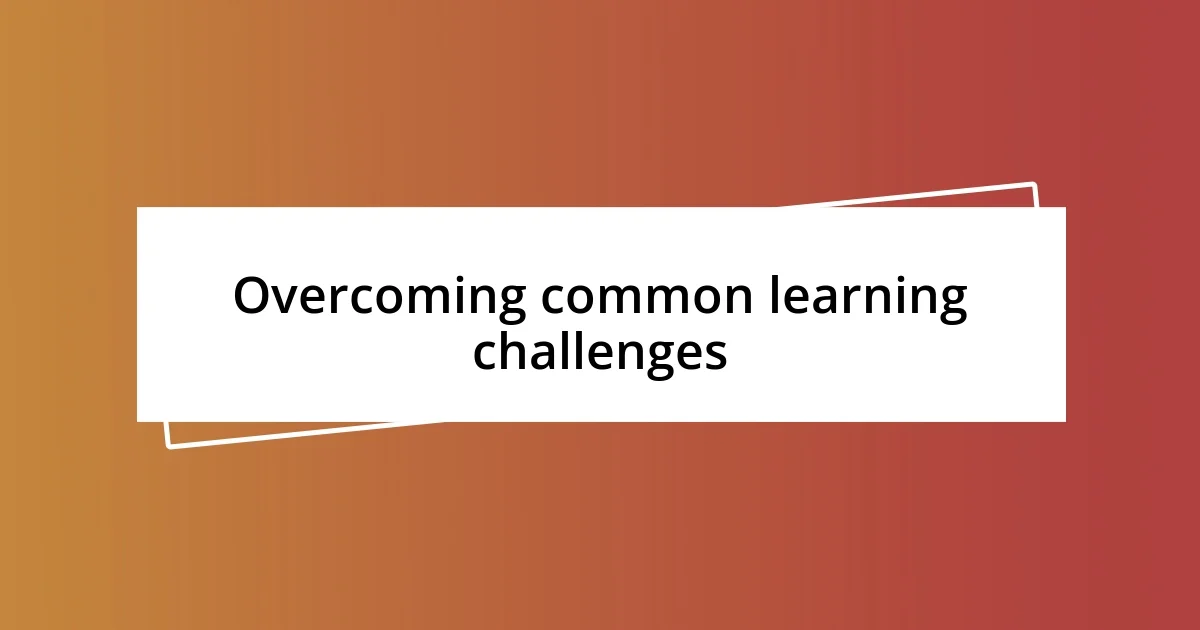
Overcoming common learning challenges
I faced my fair share of challenges while learning Python, particularly when the concepts felt daunting. I remember sitting at my desk, staring blankly at code that seemed downright alien. It made me wonder, “Am I really cut out for this?” In those moments, breaking things down into simpler parts helped. Instead of trying to grasp a whole new library at once, I would focus on one function or feature. This approach reminded me of tackling a large puzzle—focusing on fitting a few pieces first can turn a mountain into a molehill.
Another obstacle was the occasional fear of making mistakes. I distinctly recall a time when I spent hours troubleshooting a bug, only to realize I had overlooked a simple syntax error. It was frustrating, but I learned to embrace those moments. I started reframing how I viewed errors—each mistake became a stepping stone rather than a stumbling block. I’d often ask myself, “What can this teach me?” Transforming my mindset about failure made my learning process not just about the destination but the journey itself.
Finally, I dealt with the feeling of isolation that sometimes creeps in during self-paced learning. There were evenings when I would sit alone, my progress feeling stagnant, and I’d think, “Where’s my support?” That’s when joining study groups made a world of difference. Suddenly, I wasn’t just a solo learner; I was part of a collective experience. Discussing challenges and celebrating milestones together created an encouraging environment that kept me motivated. Have you considered collaborating with others? It can turn the solitary nature of learning into a vibrant journey filled with shared triumphs and support.












